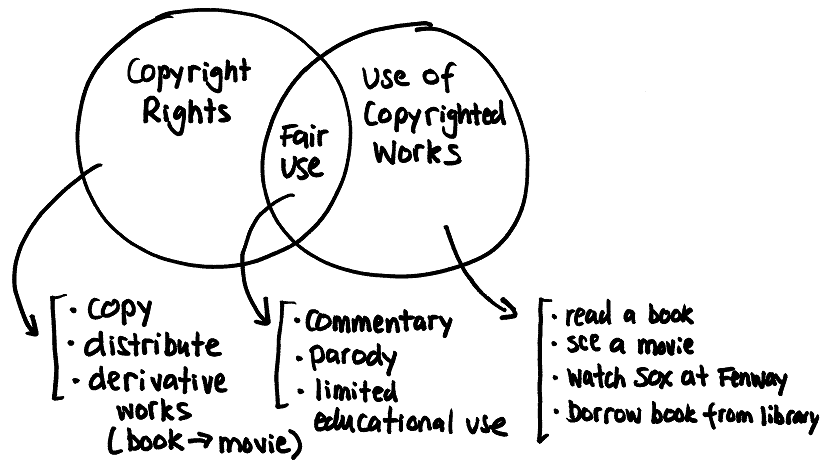Copyright rights, unregulated uses, and fair use.

On 10/19/05, the daughter of one of my MIT friends shadowed me for a day at work as part of a school project. One of the good things about spending time with children is that it forces you to explain things in simple terms. That day, I drew lots of drawings. So here is another installment Erik explaining things with drawings.
In this drawing, I attempt to explain the wonderful world of copyright law. As an aside, I think that all intellectual property (i.e. patent, trademark, copyright, and trade secret) lawyers like writing about copyright. Because we’re all familiar with stuff that copyright protects – books, movies, CDs, DVDs, radio, TV, and the like. Even if, like me, they don’t practice copyright law.
What most people don’t appreciate is that there are three types of uses of copyrighted stuff. And not all of those rights are protected by (and hence can be legally controlled by) the copyright owner. Have you ever seen a copyright notice that says “It is illegal to make a copy of this copyrighted document”? Well, that’s not true, because it excludes fair use. I’ve often thought that the Copyright Act should be amended to say that all copyright rights are forfeit if an incorrect copyright notice is placed on a work. But that will never happen. On to my drawing.
On the right side of the drawing are the uses that are unregulated, one that are not covered by copyright rights. So you don’t need permission from the copyright owner to:
- read a book
- see a movie
- watch the Red Sox at Fenway Park
- borrow a book from a library
In the middle of the drawing are uses that are covered by copyright but uses that have been declared to be “fair use” by the law. So you can use copyrighted works without permission (to some extent) for:
- commentary
- parody
- limited educational use
On the left side of the drawing are the uses that are exclusive to the copyright owners. These include the rights to:
- copy the work
- distribute the work
- make derivative works from the work (such making a moving from a book)
My drawing could be better. And my explanation could be better. But again, I drew this for a child, so it’s a good place to start. The main point is that there are three classes of uses: unregulated, fair use, and protected. And you have to think carefully about which type of use is which. Many copyright owners fail to do this, unfortunately.

This article is licensed under a Creative Commons Attribution-Noncommercial-Share Alike 3.0 United States License.



Hello Erik
Would it be ok to include your drawing in a paper about copyright I am writing for the Australian School Librarians conference?
Janet
See also:
http://www.ernietheattorney.net/ernie_the_attorney/2007/07/aba-journals-ne.html
http://legalblogwatch.typepad.com/legal_blog_watch/2007/07/a-picture-of-co.html
Greetings TemporalBeing,
Of course I miss a lot of what constitutes “fair use.” I drew this in about 30 seconds for a child. It’s copyright on a napkin, not a doctoral dissertation. For more on fair use, see:
http://en.wikipedia.org/wiki/Fair_use
http://www.copyright.gov/fls/fl102.html
http://fairuse.stanford.edu/
I am not saying that it is possible to copyright sitting at a baseball game. I am saying exactly the opposite. Namely, that there are a whole bunch of ways to use copyrighted works that do not require the permission of the copyright holder because they are not regulated uses. So you do not need permission from J. K. Rowling to read the latest Harry Potter novel (an unregulated use), and you would not need her permission to write a critique of the book that included excerpts of the book (fair use), but you would need her permission to create a movie from the novel (derivative work).
And no, I do not work for the RIAA. But thanks for asking.
Regards,
Erik
You seem to miss a lot of what falls under fair use. For example, fair use also covers some forms of reverse engineering, churches, archives, libraries, and a lot of other stuff. You do get the basic points across, but you over simplified it so much that you lose a lot of what the law really says. Additionally, as others have pointed out, you are giving copyright to areas that are not possible to copyright – such as sitting at the baseball game itself to see the game. Please make the corrections so that others are not mis-informed by your work, and lead astray by your claims to be a lawyer. (It almost makes me wonder if you work for the RIAA!)